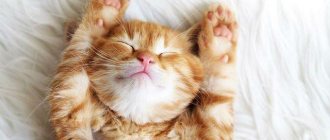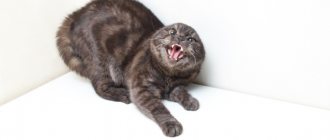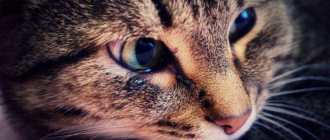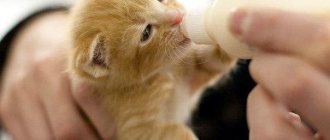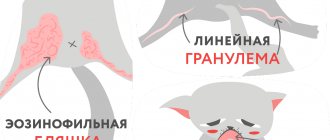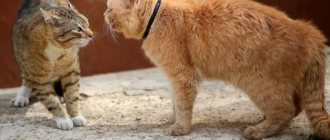The results of recent studies have confirmed what cat lovers already knew - these graceful animals become attached to their owners like children. Moreover, cats are not at all asocial animals and remember their names perfectly. However, very often communication with a cat is complicated by mutual misunderstanding: we do not always recognize not only the needs and desires of the cat, but also do not understand its behavior. But the position of the body, ears and tail can tell a lot about how these amazing animals feel. However, the most surprising results were the results of the online study catdogwelfare - you can understand its mood by the expression of a cat’s face.
A happy cat is a happy cat (and his human)
Purring and other sounds
This is the most understandable signal for such a talkative creature as a person. Everyone knows that a purring cat is a happy cat, although in fairness it should be said that she makes vibrating sounds not only when she is happy. For example, older cats may purr when approaching younger ones to show that they are friendly and do not claim power.
Animals can purr to calm themselves down in a stressful situation. But, basically, it is still a sure sign of contentment, just like meowing in certain situations. For example, when a cat enters a room and, seeing you, utters a melodious “meow”, then most often it wants to say: “I’m happy to see you! And don’t I deserve attention and affection for this?”
How to understand what a cat wants?
Although cats may seem mysterious, by carefully observing their behavior you can understand how they feel. The position of the body, head, ears and tails are hints. An anxious or frightened cat may sit down on the ground, arch its back, lower its head, and straighten its ears. By the way, people are not so different from cats - when we are scared, we also retreat back, hide, the hair on our body stands on end (this is called piloerection), and we can also fight and even bite. As for cats, when they are happy, they may approach you with their tail up and ears forward. When cats are at rest, they curl their paws or lie on their sides with their legs extended.
A cat's facial expression can also tell a lot about its mood. Researchers have found that some people can easily tell when cats are in pain. Despite this, the full range of facial expressions in cats, including in positive situations, has not been thoroughly examined.
By the way, on our Yandex.Zen channel you will find even more interesting articles about the relationship between man and our little brothers.
This cat is probably very unhappy about something.
During the online study, subjects were shown short videos of cats in various situations. Positive situations included cats approaching their owner for a treat, while negative situations included cats trying to avoid meeting a person unknown to them. The videos were carefully selected based on strict behavioral criteria and edited so that subjects could only see each cat's face, removing any other cues from the animals' body language or location.
More than 6,300 people from 85 countries took part in the study. Subjects determined whether the animal's mood in each video was positive or negative. By the way, if you want to try your hand at this difficult task, you can do it right now.
And the results obtained can be shared in the comments to this article, as well as with participants in our Telegram chat.
On average, participants identified the correct cat facial expression 59% of the time. While this estimate is little better than a common guess, it does suggest that many people have difficulty recognizing cats' emotions. However, despite the fact that most of the subjects found it difficult to understand the mood of cats, 13% turned out to be real charmers, scoring 15 or more points out of a possible 20. Mostly women fell into this group, which, according to the researchers, is not surprising - previous Research has shown that women are better at interpreting nonverbal emotional cues.
But for this guy, on the contrary, things are going uphill
Veterinarians and people who deal with large numbers of cats every day and must learn to interpret their behavior and recognize diseases also did an excellent job. What's even more surprising is that cat owners aren't as good at recognizing their pet's emotions as those who've never had a cat at home. According to researchers, this situation may be due to the fact that we recognize the emotions of our animals well, but problems may arise with interpreting the emotions of unfamiliar cats.
Fingering with paws
Cat massage - no matter how it is called in different languages! And “kneading dough”, and “kneading puree”, and “playing the piano”, and - if the cat’s claws are not trimmed - even “free acupuncture”. But no matter what fancy names they come up with for this phenomenon, its essence remains unchanged. These are the movements that kittens make while suckling their mother, kneading her belly for a better flow of milk.
Considering the pleasure that the process of eating their first food brings to babies, it is not difficult to guess that in adult life they make such movements only in moments of the highest contentment associated with a feeling of complete comfort and security.
Why your cat doesn't purr and what to do about it
Is it possible to make a cat purr? No, especially if she is not naturally inclined to do this. And that's okay: not everyone feels the need to express emotions by purring. There are even breeds that are not inclined to turn on their “engines” - Ragdolls and Devon Rex. Here, again, there are exceptions.
Getting a purr to do anything is very difficult in general, and with purring and other ways of expressing emotions it is even more difficult. This partly explains the impossibility of accurately diagnosing the mechanics of the appearance of iridescent sounds in predators. Nobody wants to purr in an MRI machine or during an ultrasound.
Sometimes this “insensitivity” is related to previous negative experiences. If the cat has been with bad owners or on the street, it may simply be afraid to show emotions by purring. You can try to help your cat make the desired sounds. Play with her, caress her, introduce treats into her diet (always natural) and demonstrate by your behavior that you are a safe person.
Tail signals
The tail is the most “talking” organ of a cat. And no wonder, because it is part of the spine through which the spinal cord passes, which performs many different functions, including the transmission of signals from the brain associated with emotions. The most obvious sign of a satisfied and happy cat is its tail held high vertically.
It, like a flag over a conquered fortress, speaks of the cat’s complete victory over the surrounding space and its confidence in its own safety. No less eloquent is the small twitching of the very tip of the tail - in this way the cat expresses the joy of meeting you.
What else does a cat's tail mean?
In addition to joy, a cat's tail can express a whole range of feelings and experiences.
Take a close look at the picture: these signals show what your delicate pet is actually experiencing at the moment:
- Friendliness, contentment;
- Uncertainty;
- Disdain: “I don’t care about you!”;
- Trembling tail: “I'm glad to see you!”;
- Friendliness with a hint of uncertainty about the situation;
- Friendliness and confidence in the favorable situation;
- Defensive aggression;
- “Sweeping the floor” with the tail - aggression or irritation;
- Tousled tail - aggression;
- Potential aggression;
- Submission;
- Twitching of the tail is a warning, intense interest.
High relationship
Think about how to raise an affectionate cat if your pet constantly feels tension, stress and anxiety? Of course not. A contact trusting cat is a cat that feels safe. What do small cats do when threatened? Of course, they climb the nearest tree. It just so happens that in nature cats have almost no enemies capable of catching up with the agile steeplejack. Therefore, it is extremely important that the cat has a lot of shelters at height: playing complexes in the ceiling, “trees” for climbing, hanging houses, shelves and ladders.
"Blind Man's Bluff"
Not only cats, but also people squint their eyes with pleasure. But if for us this is still a sign of purely physical pleasure (for example, when you decide not to give a damn about your diet and finally sink your teeth into a juicy, airy cake), then in animals this gesture is of a broader nature.
Slow and incomplete lowering of the eyelids, squinting the eyes when looking at another creature, means complete and unconditional trust in him. For cats, this means a real declaration of love. To reciprocate, you can repeat this gesture while looking at the cat.
The benefits of a cat's purring for humans
Our smaller furry brothers are real doctors. There is even feline therapy - treatment by communicating with cats. Pet owners cope better with stress, are less likely to become depressed, are more sociable and, in general, are healthier than people without pets. Why is purring useful?
Cats are furry physiotherapists. At a frequency of 25-50 Hz, bone tissue responds to purring, and at 100 Hz, skin and soft tissues respond. It's not as crazy as it may seem: the body's tissues respond to pressure by becoming stronger. Scientists even propose using this property of vibration for astronauts so that their bones do not lose their density in zero gravity.
A purring cat pleases the human heart. This means that having a pet in the home reduces the likelihood of having a stroke by a third. “Pur-mur-mur” is a kind of white noise, to which the owner calms down and falls asleep more easily.
Thus, not all purring kittens and cats are happy with their situation. A purring pet can feel both joy and pain. This amazing means of communication allows animals to communicate with each other and get what they want from humans. If a cat likes food or, conversely, is hungry, it will purr. This is done by domestic purrs, cheetahs, and pumas. But if your pet does not want to purr, this is also not a problem, and you can do nothing about it.
"Butting"
When a cat rubs its head against your legs or face, sometimes making funny “butting” movements, it leaves on you the scent of a secretion secreted by the glands on the sides of the animal’s head. A person cannot distinguish this smell, but for a cat it is of utmost importance. Thus, she marks everything that she considers completely safe for herself. And if you have the honor of being among these selected items, then you can be sure that next to you is a completely satisfied and happy cat.
I eat it myself, I won’t give it to anyone!
A very affectionate cat is a contented cat. And what kind of satisfaction can we talk about when people interfere in such an intimate process as eating? Remember how cats eat in nature - alone, away from everyone, in a secluded place. The beloved should eat in a calm environment, on an elevated platform, without the accompaniment of an orchestra of rattling pans. The cat does not understand that the child screaming nearby is not at all encroaching on her lunch. Eating in constant tension, hastily, swallowing huge pieces, the cat experiences stress.
Ear signals
A cat's ears, although they can turn almost 180 degrees and lie almost completely against the head, are not as expressive as the tail in expressing joy. Ears raised vertically indicate both an extreme degree of interest and a warning. But those leaning slightly forward are a sign of a good, playful mood.
Toys or games?
Manufacturers of pet products regularly replenish the range of toys with a variety of options for “prey” for domestic predators: wind-up mice, on a string, on a spring, glowing balls, fragrant fish and fishing rods... But to raise a cat to be affectionate and sociable, it is not enough to spend a certain amount on new items from the store . Games must be joint, regular, within the family circle. By playing together, a person and a cat learn to understand each other, trust each other and, ultimately, certainly become closer.
Never use your hands or feet to try to get your cat's attention. Don't tease her by scratching your fingers along the upholstery of the sofa. Human legs and arms are an absolute taboo. Explain to everyone at home that scratched skin and torn clothes are not your dream. If a kitten attacks in the heat of play, grabbing the skin with its teeth or claws, do not pull your hand away. Freeze, look closely at the bully and hiss threateningly - he will let you go...
Other body signals
Cats arch their backs at times of great danger and meeting the enemy face to face. This, along with the raised fur, makes the animal visually larger and gives a chance to scare the offender before he decides to attack. But arching its back with smoothly pressed fur only means that the cat is stretching sweetly and is about to lie down comfortably to continue enjoying life.
The choice of sleeping position is also very eloquent. If your cat often sleeps on its back, exposing its most vulnerable place - its stomach, then this means the highest degree of trust in you and in everything around you. Every cat lover knows how great the temptation is to stroke a soft belly at this time. But we advise you to restrain yourself - do not destroy your pet’s trust!
It’s better to just look and be touched, remembering that tenderness is a very strong and purely positive emotion that will add to your good mood no less than tactile sensations.
If we understand happiness as a state when there is nothing more to desire, then cats, of course, have it much easier than people. Safety, satiety, some fun games - that’s all they need. So, making a cat happy is not at all difficult, but looking at an animal happy with life means, you see, to become a little happier yourself.
Larisa Solodovnikova
Tenderness on schedule
Remember that this is not a battery-powered toy, but a living creature. Only a few pets are willing to wait forever until the owner has time to communicate. A very affectionate cat is a caressed cat with whom they “talk”, hug, watch TV together and relax together reading the newspaper. But there is so much work and other important things to do... As they say, let the whole world wait, ten minutes of respite will not hurt anyone.
You can’t get a kitten when you have little time left to communicate with it. The kitten will grow up quickly, and he will grow up unsociable, not tame and not affectionate. Even adult animals, which were temporarily forgotten, are gradually becoming wild. And the baby, growing up alone, will close himself off from people with a thick wall of mistrust...
However, you should not impose. Cats, like people, can have different moods. Even an overly affectionate cat sometimes wants to take a peaceful nap on the windowsill or just sit in deep thought on important cat topics. As you pass by, scratch the beauty behind the ear - fleetingly, without pressure. She answered with a purr - we can “talk” a little. Didn't you deign to purr? Well, okay, we'll talk later. Many owners are surprised why their cat is not affectionate: “We pet her all day, scratch her, hug her, there is always someone at home and we always make contact, but she just doesn’t want to purr and be caressed.” Where exactly! I wouldn’t howl like a dog at such a blatant violation of the intimate area!
How to distinguish a cat from a female cat at a young age
Newborn kittens are quite difficult to distinguish by gender. The babies are not yet fully formed, the genitals are underdeveloped - it will not be possible to visualize the gender with obvious accuracy, behavioral skills are not expressed, and the color may change its shade during the first months.
What to do in this case?
- In this case, only a DNA test can give an accurate answer.
- An examination by a specialist allows you to roughly determine by gender - an experienced veterinarian will be able to tell with a certain accuracy whether the animal in front of you is a cat or a female cat based on the weight, shape of the skull and constitution of the animal.
- The last option is to still try to identify the pet by its genitals. This will be true if the animal is not too fluffy. It is recommended to try this method from 2.5-3 months of age.
In very young kittens it is easier to identify the gender, having the opportunity to compare: if you have several kittens in front of you and one of them has already been assigned to a certain gender type, then the gender of the next one is easier to determine by external comparative characteristics.

